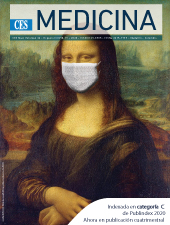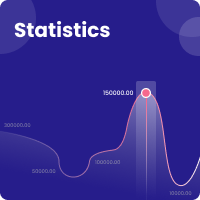COVID-19 and Diabetes. Challenges, Implications and treatment during the pandemic
DOI:
https://doi.org/10.21615/cesmedicina.34.COVID-19.13Keywords:
SARS-CoV-2, COVID-19, DiabetesAbstract
Since the end of the year 2019 a new coronavirus called Severe Acute Respiratory Syndrome (SARS-CoV-2) has spread from China to the rest of the world, causing the pandemic of the disease called COVID-19. A systemic disease that in some cases produces severe pneumonia that can even progress to acute respiratory failure and eventually death. Among the comorbidities that have been associated with an increase in mortality from SARS-CoV-2, diabetes is one of them. In general, it is estimated
that having diabetes increases the risk of respiratory infections by 18 %, in part, due to the impact on innate and acquired immunity, which would be
contributing to a more severe clinical presentation of SARS-CoV-2 when compared with population without diabetes. Considering that there is an association between worse glycemic control and higher clinical severity of COVID-19 infection, important considerations must be made regarding the type of pharmacological management that is provided to patients, the profiling will depend on the conditions of each patient, the severity of the disease, and the type of management either as outpatient or in-hospital.
Downloads
References
Kornum JB, Thomsen RW, Riis A, Lervang H-H, Schønheyder HC, Sørensen HT. Diabetes, glycemic control, and risk of hospitalization with pneumonia: a population-based case-control study. Diabetes Care. 2008;31 (8):154-5.
Hui DSC, Zumla A. Severe acute respiratory syndrome: historical, epidemiologic, and clinical features. Infect dis Clin North Am. 2019;33 (4):869-89.
Puig-Domingo M, Marazuela M, Giustina A. COVID-19 and endocrine diseases. A statement from the European Society of Endocrinology. Endocrine. 2020;68 (1):2-5.
Memish ZA, Perlman S, Van Kerkhove MD, Zumla A. Middle East respiratory syndrome. Lancet. 2020;395 (10229):1063-77.
Roser M, Ritchie H, Ortiz-Ospina E, Hasell J. Coronavirus Pandemic (COVID-19). Our World Data [Internet]. 4 de marzo de 2020 [citado 11 de mayo de 2020]; Disponible en: https://ourworldindata.org/coronavirus
Instituto Nacional de Salud de Colombia (INS). El Coronavirus en Colombia [Internet]. [citado 11 de mayo de 2020]. Disponible en: https://coronaviruscolombia.gov.co/Covid19/
Saxena SK, editor. Coronavirus Disease 2019 (COVID-19): epidemiology, pathogenesis, diagnosis, and therapeutics [Internet]. Springer Singapore; 2020. (Medical virology: from pathogenesis to disease control). Disponible en: https://www.springer.com/gp/book/9789811548130
Yang J-K, Lin S-S, Ji X-J, Guo L-M. Binding of SARS coronavirus to its receptor damages islets and causes acute diabetes. Acta Diabetol [Internet]. 2010;47 (3):193-9. Disponible en: https://www.ncbi.nlm.nih.gov/pmc/articles/PMC7088164/
Fernandez C, Rysä J, Almgren P, Nilsson J, Engström G, Orho-Melander M, et al. Plasma levels of the proprotein convertase furin and incidence of diabetes and mortality. J Intern Med [Internet]. 2018;284 (4):377-87. Disponible en: https://www.ncbi.nlm.nih.gov/pmc/articles/PMC6175079/
Guan W, Ni Z, Hu Y, Liang W, Ou C, He J, et al. Clinical characteristics of Coronavirus Disease 2019 in China. N Engl J Med. 2020;382 (18):1708-20. Disponible en: https://doi.org/10.1056/NEJMoa2002032
Coomes EA, Haghbayan H. Interleukin-6 in COVID-19: A systematic review and meta-analysis. medRxiv 2020.03.30.20048058. Disponible en: https://doi.org/10.1101/2020.03.30.2004805812.
Hoffmann M, Kleine-Weber H, Schroeder S, Krüger N, Herrler T, Erichsen S, et al. SARS-CoV-2 cell entry depends on ACE2 and TMPRSS2 and is blocked by a clinically proven protease inhibitor. Cell. 2020;181 (2):271-280.e8.
Broxmeyer HE, Capitano M, Campbell TB, Hangoc G, Cooper S. Modulation of hematopoietic chemokine effects in vitro and in vivo by DPP-4/CD26. Stem Cells Dev [Internet]. 2016;25 (8):575-85. Disponible en: https://www.ncbi.nlm.nih.gov/pmc/articles/PMC4834524/
Meyerholz DK, Lambertz AM, McCray PB. Dipeptidyl peptidase 4 distribution in the human respiratory tract: implications for the Middle East respiratory syndrome. Am J Pathol. 2016;186 (1):78-86.
Inn K-S, Kim Y, Aigerim A, Park U, Hwang E-S, Choi M-S, et al. Reduction of soluble dipeptidyl peptidase 4 levels in plasma of patients infected with Middle East respiratory syndrome coronavirus. Virology. 2018;518:324-7.
Lin L, Jiang X, Zhang Z, Huang S, Zhang Z, Fang Z, et al. Gastrointestinal symptoms of 95 cases with SARS-CoV-2 infection. Gut. 2020;69 (6):997-1001.
Onder G, Rezza G, Brusaferro S. Case-Fatality Rate and Characteristics of Patients Dying in Relation to COVID-19 in Italy. JAMA 2020;323 (18):1775–6.18.
Grasselli G, Zangrillo A, Zanella A, Antonelli M, Cabrini L, Castelli A, et al. Baseline characteristics and outcomes of 1591 patients infected with SARS-CoV-2 Admitted to ICUs of the Lombardy Region, Italy. JAMA. 2020;323 (16):1574–81.
CDCMMWR. Preliminary estimates of the prevalence of selected underlying health conditions among patients with Coronavirus Disease 2019 — United States, February 12–March 28, 2020. MMWR Morb Mortal Wkly Rep [Internet].mmwr/volumes/69/wr/mm6913e2.htm
Zhou F, Yu T, Du R, Fan G, Liu Y, Liu Z, et al. Clinical course and risk factors for mortality of adult inpatients with COVID-19 in Wuhan, China: a retrospective cohort study. Lancet. 2020;395 (10229):1054-62.
Henry BM, de Oliveira MHS, Benoit S, Plebani M, Lippi G. Hematologic, biochemical and immune biomarker abnormalities associated with severe illness and mortality in coronavirus disease 2019 (COVID-19): a meta-analysis. Clin Chem Lab Med. 2020; 58 (7):1021-1028.
Wang Z, Du Z, Zhu F. Glycosylated hemoglobin is associated with systemic inflammation, hypercoagulability, and prognosis of COVID-19 patients. Diabetes Res Clin Pract. 2020 Jun;164:108214.
Kajiwara C, Kusaka Y, Kimura S, Yamaguchi T, Nanjo Y, Ishii Y, et al. Metformin Mediates Protection against Legionella Pneumonia through Activation of AMPK and Mitochondrial Reactive Oxygen Species . J Immunol. 2018;200 (2):623–31.
Bornstein SR, Rubino F, Khunti K, Mingrone G, Hopkins D, Birkenfeld AL, et al. Practical recommendations for the management of diabetes in patients with COVID-19. Lancet Diabetes Endocrinol. 2020;8 (6):546-50.
Deusenberry CM, Coley KC, Korytkowski MT, Donihi AC. Hypoglycemia in hospitalized patients treated with sulfonylureas. Pharmacother J Hum PharmacolDrug Ther [Internet]. 2012 Jul 1;32 (7):613–7
Raj VS, Mou H, Smits SL, Dekkers DHW, Müller MA, Dijkman R, et al. Dipeptidyl peptidase 4 is a functional receptor for the emerging human coronavirus-EMC. Nature. 2013;495 (7440):251-4.
Iacobellis G. COVID-19 and diabetes: Can DPP4 inhibition play a role? Diabetes Res Clin Pract. 2020;162:108125.
Drucker DJ. Mechanisms of action and therapeutic application of glucagon-like peptide-1. Cell Metab. 2018;27 (4):740-56.
Viby N-E, Isidor MS, Buggeskov KB, Poulsen SS, Hansen JB, Kissow H. Glucagon-like peptide-1 (GLP-1) reduces mortality and improves lung function in a model of experimental obstructive lung disease in female mice. Endocrinology. 2013;154 (12):4503-11.
Zhou F, Zhang Y, Chen J, Hu X, Xu Y. Liraglutide attenuates lipopolysaccharide-induced acute lung injury in mice. Eur J Pharmacol. 2016;791:735-40.
Downloads
Published
How to Cite
Issue
Section
License
Copyright (c) 2020 CES Medicina

This work is licensed under a Creative Commons Attribution-NonCommercial-ShareAlike 4.0 International License.
Derechos de reproducción (copyright)
Cada manuscrito se acompañará de una declaración en la que se especifique que los materiales son inéditos, que no han sido publicados anteriormente en formato impreso o electrónico y que no se presentarán a ningún otro medio antes de conocer la decisión de la revista. En todo caso, cualquier publicación anterior, sea en forma impresa o electrónica, deberá darse a conocer a la redacción por escrito.
Plagios, duplicaciones totales o parciales, traduccones del original a otro idioma son de responsabilidad exclusiva de los autores el envío.
Los autores adjuntarán una declaración firmada indicando que, si el manuscrito se acepta para su publicación, los derechos de reproducción son propiedad exclusiva de la Revista CES Medicina.
Se solicita a los autores que proporcionen la información completa acerca de cualquier beca o subvención recibida de una entidad comercial u otro grupo con intereses privados, u otro organismo, para costear parcial o totalmente el trabajo en que se basa el artículo.
Los autores tienen la responsabilidad de obtener los permisos necesarios para reproducir cualquier material protegido por derechos de reproducción. El manuscrito se acompañará de la carta original que otorgue ese permiso y en ella debe especificarse con exactitud el número del cuadro o figura o el texto exacto que se citará y cómo se usará, así como la referencia bibliográfica completa.
| Article metrics | |
|---|---|
| Abstract views | |
| Galley vies | |
| PDF Views | |
| HTML views | |
| Other views | |



